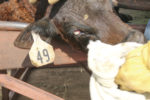Cattle Diseases
ARTICLES
Bovine neosporosis can cause abortions between four and seven months of gestation, and the dam doesn’t show any symptoms until it occurs.
Read More
Herd health and biosecurity were at the forefront of CattleCon presentations
Herd health and biosecurity insights were shared during Cattlemen’s College at NCBA’s CattleCon 2025 in San Antonio, Texas. Now is the time to protect your operation from harmful diseases.
Read More
Cleaning up BRD, Part 2
While several critical control points have been recognized for implementation in a Hazard Analysis Critical Control Points plan, additional critical control practices are needed to further reduce the frequency of BRD.
Read More
Why respiratory vaccines seem to fail
Effective cattle management, vaccine selection, timing and nutrition are necessary for cattle respiratory vaccines to be effective. When coupled with realistic expectations, vaccination of cattle for BRD can be greatly beneficial and rewarding.
Read More
Tips to manage stressors and minimize BRD
A common summer challenge is dealing with BRD. Mitigating risk is a critical component of a larger BRD battle plan. Risks can range from new cattle entering the herd to stressors caused by handling, nutrition and environment.
Read More
Don’t stress: Here’s how to handle the heat
Several factors can lead to stress in cattle and, although some are out of our control, there are steps producers can take to minimize stress and keep animals healthy.
Read More
Foothill abortions: All from a little tick
Foothill abortions have been perplexing producers in the West for many years. These large numbers of strange, late-term abortions in otherwise healthy cattle can be devastating. They are caused by the bacteria Pajaroellobacter abortibovis and spread by a little-known soft-shell tick, pajaroello.
Read More
Timing is everything for BRD protection
BRD is the costliest disease in the cattle industry and can have serious impacts on an animal’s production potential. Attacking BRD with a multifaceted approach that includes building immunity, mitigating risk and managing infections is important.
Read More
Essential practices to build BRD resilience in your calf crop
The path to economic success for cow-calf producers often hinges on the ability to develop healthy herds that are resilient to common management and disease challenges.
Read More
What are you doing to prevent pinkeye?
Pinkeye is not like other diseases. Many factors can contribute to an animal having the disease. However, there are also many ways a producer can work to prevent and treat this disease.
Read More












